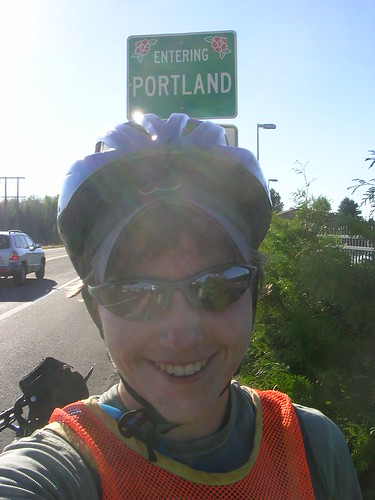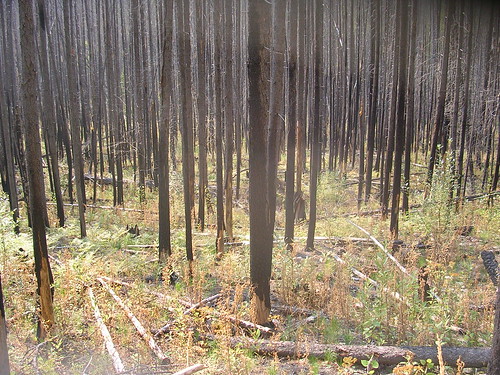Tuesday, September 26, 2006
Thursday, September 21, 2006
Geography Lesson
Walla Walla, WA -- Last night the nice folks I'm staying with here outside Walla Walla offered me clam chowder and I realized that I probably don't need to be as suspcious of seafood as I have been since I'm in a state with a coastline again. I've still been asking people for directions and tips on how to move forward, but I'm getting close enough there are really only a couple roads that run from where I am towards Portland.
I've been thinking, though, about all the directions I've gotten since I started and all that I've been told about the roads ahead of me by people who've been on them. I met a man in Bartonville, IL who had been all around the country on his motorcycle and who now worked, in his retirement, moving new cars between dealerships in the midwest. He had been in all of the contiguous states, riding twelve hour, sixteen hour, thousand mile days. He once rode from Denver to Reno, he told me, on the loneliest higway in America. He went to whole way on only two bottles of Gatorade.
When I told him I was from outside Boston. "Oh," he said, "Route 95." I said I'd be headed due west across Iowa and he told me it was three hundred and two miles on Interstate 80. Heading due west, he figured, I must be going through Denver, right? Before he could give me the mileage for that, I told him that no, I wouldn't be going through Denver. Denver is actually a bit south of Bartonville, but if you get on 80 West and don't stop, it'll take you there.
When I ask people for directions, they describe distances in terms of time in a car, they never think I can cover as much ground in a day as I can, and they usually don't know the backroads as well as they know bigger ones. People are much less likely to tell me the direct, diagonal county road to where I'm going than they are to tell me to go ten miles straight north on a highway with a 60-plus speed limit and then ten miles straight west on another. I do it too. When people ask about where I'm from I describe a town about half an hour outside of Boston
It makes sense, I suppose, that a person's mental geography reflects the things they do, the places they go, and how they go there, but I'd never given it much thought before this trip. People often don't notice whether they're going uphill or downhill because they're driving, and I've been tipped off to "short cuts" that end up being really steep climbs. I also get directions that reference local landmarks -- the local Wal-Mart or grocery store is a common one. I can also tell where people don't go from what they say to me. In Piqua, OH, a man in a diner told me that I was over four hundred miles from Indianapolis, but the actual distance was more like a hundred and twenty.
My mental map of the country, of course, has changed considerably since I started. Being able to conjure up images of places in South Dakota, Iowa and Idaho when I see them on a paper representation of the continent makes a world of difference, ad even having heard about places changes the way I think about them. In Orofino, a man told me he once drove on the lonliest highway in America and I said, "Oh, Reno to Denver."
Well, it's onwards for me. It'll be less than I week until I get to Portland, and I might not post again until then. Last night someone asked me if I was sad about my trip being almost over, and I almost surprised myself with my answer. I said that I hadn't thought about it, but that I was just about ready to be done. I've seen what a lot of people's lives are like in a lot of different places, but I'm about ready to see what my life is going to be like.
Posted by
Maggie
at
8:25 AM
3
comments
![]()
Sunday, September 17, 2006
Lumberjacks, Lumberjills, and the Highest Straight-Axis Dam in North America
Still in Orofino, ID -- Two things happened that led me to spend the last two days in Orofino, and it's turned out to be an excellent stop on my trip.
For starters, Orofino is having Lumberjack Days, which is the county fair for Clearwater County and an occasion for a lumberjack competition. That's the first thing, and it led me to ask at the fire station where I might camp in town for the night so that I could see the fair. There, I met the county's wonderful emergency manager. That's the second thing. I've been camping in his yard and hanging out with his family, and they're all a whole bunch of fun.
The Dworshak Dam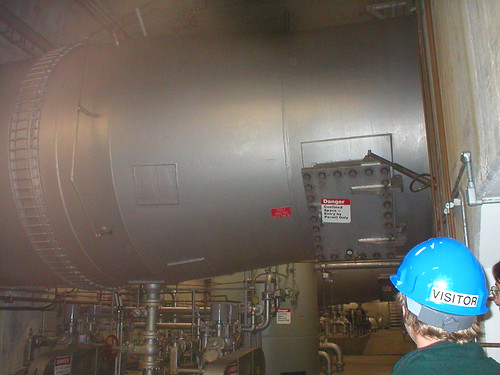
One of my host heads-of-house works at the Dworshak Dam, a 717 footer across the North Fork of the Clearwater River a little ways out of town. She took me in on an after-hours tour of the Visitor's Center, the North Tower, level 1603 (1603 ft above sea level), and then down into the Power House where the plant's operator showed us his control room and the switches, pistons, rotors, breakers and other things that make electricity out of water.
The operator can run everything from the control room. There were probably 9 or 10 computer monitors in it, in addition to all the LED displays and lit-up dials. We saw the old, manual controls on one of the generators, breakers for the electricity that gets generated, and we got to listen to one of the generators whir around as the water passed through it.
The dam, which does have the distinction of being the highest stright-axis gravity dam in North America (for you damophiles out there), has three generators, but only one was running because it's late in the season and water levels are pretty low. The dam is owned and operated by the Army Corps of Engineers, but it sells its power to the local electric company and sends it to the town of Ororfino as well as to places further afield in the Northwest.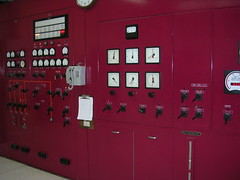 The Dworshak is one of eight in the way of Salmon and Steelhead trout that come this way from the Pacific to spawn. Their stop up in these parts is the Dworshak Fishery, just downshtream from the Dam, and they make quite a journey to get here. Some of the dams have fish ladders and various other contraptions to help fish around them, but in some places the Federal Fish & Wildlife administration actually scoops the fish up on one side of the dam, puts them in water-filled trucks, and brings them to the other side.
The Dworshak is one of eight in the way of Salmon and Steelhead trout that come this way from the Pacific to spawn. Their stop up in these parts is the Dworshak Fishery, just downshtream from the Dam, and they make quite a journey to get here. Some of the dams have fish ladders and various other contraptions to help fish around them, but in some places the Federal Fish & Wildlife administration actually scoops the fish up on one side of the dam, puts them in water-filled trucks, and brings them to the other side.
At the Dworshak Fishery the eggs are collected from adult fish, the fish spawn, and some orther fish things happen. I don't understand all the details of that after talking to one former and one current employee of the fishery, but I do understand that it's massively expensive. The dams seem to work more or less like this: the government builds these dams and sells the power. It has to pay out the nose, though, to mitigate the disasterous effects the dams would otherwise have on the fish. So there's cheap, clean electricity in the Northwest, but the government subsidizes it both by running the dams and taking care of the fish. Why bother, having dams at all, then? Well, conveniently, they're a power subsidy that doubles as a farm subsidy. The downstreams dams all have locks and they make it possible for grain to go downstream to Portland and overseas from there.
So the dams allow power and grain to travel around the Northwest, but they impede the progress of fish on the river, and they also impede the path of logs. When the Dworshak Dam was completed in 1971 it was the end of log drives down the North Fork of the Clearwater, and timber has been trucked rather than floated to market ever since. Timber is still big business around here, though not as big as it once was, and culturally important. Hence...
Lumberjack Days
Friday and Saturday were the usual county fair stuff -- food, rides, prize-winning vegetables and a 4-H auction -- and Sunday was a lumberjack competition. Both days of the fair were a lot of fun. There was an exhibit hall that had prize winning fruits, art projects, and baked goods, as well as booths put up by a variety of organizations. Basically, it was one of my dreams come true -- a whole bunch of knowledgeable, friendly people lined up and waiting for me to ask them questions.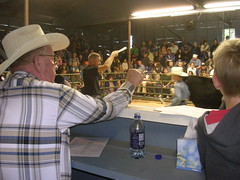 I talked to people from the Forest Service, Fish and Game, various political candidates (There's a particularly heated race for Clearwater County Coroner this year.), and a man who makes and engraves knives. I also went to the 4-H auction for a while to see the animals and listen to the auctioneer. A good day at the fair.
I talked to people from the Forest Service, Fish and Game, various political candidates (There's a particularly heated race for Clearwater County Coroner this year.), and a man who makes and engraves knives. I also went to the 4-H auction for a while to see the animals and listen to the auctioneer. A good day at the fair.
Today was the log show -- pretty much a timber industry version of the rodeo. People compete in skills that used to be what loggers did at their jobs. I talked to a team memeber from Washington State University and she explained to me that it's actually quite widespread and well organized under the American Lumberjack Association. There's also a good deal of international competition, she said. Australia and New Zealand have some great loggers, apparently.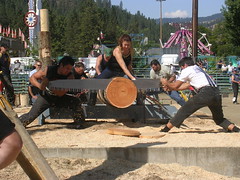 There were a bunch of events in the Orofino show. Competitors chopped wood in various ways, threw axes at a target, climbed sixty foot poles, sawwed logs (by hand and with chainsaws, alone and in pairs) and performed various agility events. My favorite was birling , which tests skills that a lumberjack or lumberjill would have used in the days of the log drives when they were floating logs down the river. Two people stand on a log floating in a pool of water and each tries to spin and stop the log with their feet so that they knock the other person off. One Lumberjill (I may have had a crush on her. Okay, I had a crush on her.) who had competed internationally did an especially good job at the birling. She made it look easy, but it ws pretty clear from a lot of the other Jacks' and Jills' performances that it isn't.
There were a bunch of events in the Orofino show. Competitors chopped wood in various ways, threw axes at a target, climbed sixty foot poles, sawwed logs (by hand and with chainsaws, alone and in pairs) and performed various agility events. My favorite was birling , which tests skills that a lumberjack or lumberjill would have used in the days of the log drives when they were floating logs down the river. Two people stand on a log floating in a pool of water and each tries to spin and stop the log with their feet so that they knock the other person off. One Lumberjill (I may have had a crush on her. Okay, I had a crush on her.) who had competed internationally did an especially good job at the birling. She made it look easy, but it ws pretty clear from a lot of the other Jacks' and Jills' performances that it isn't.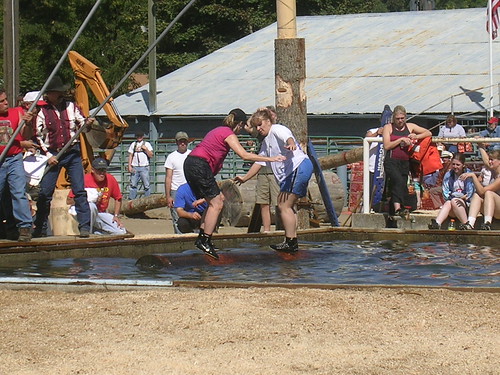
My stay in Orofino has been a lot of fun, but onwards I go. Portland seems almost in sight -- I'll be in Washington state by the end of tomorrow. I've already succeeded in one of the goals of my trip, though -- I made it out of the mountains before the snow. It snowed on Lolo pass yesterday, where I camped two nights ago.
Oh, and one more thing. I was interviewed by a reporter from a local online news service. I don't know when the story will go up, but you can check for it and learn more about the fair and everything else going on in Clearwater County at Window on the Clearwater.
Posted by
Maggie
at
8:14 PM
4
comments
![]()
Friday, September 15, 2006
Getting into Hot Water
Orofino, ID -- Whoever decided that "Idaho: Famous Potatoes" would be a good license plate motto owes the state a serious apology. Better, I'd say would be "Idaho: Surprisingly Gorgeous" or since the damage has already been done, perhaps "Idaho: Much More than Potatoes."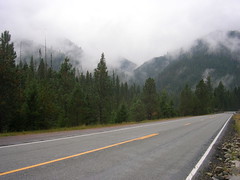 Yesterday, my first full day in Idaho, was my best, or at least most luxurious, day of riding so far. Someone told me at the campground that my day was going to be all downhill and I was skeptical. People tell me that sort of thing all the time when I ask for directions and they're usually just wrong. It's not their fault -- it's hard to judge slope from a car -- but they're usually wrong.
Yesterday, my first full day in Idaho, was my best, or at least most luxurious, day of riding so far. Someone told me at the campground that my day was going to be all downhill and I was skeptical. People tell me that sort of thing all the time when I ask for directions and they're usually just wrong. It's not their fault -- it's hard to judge slope from a car -- but they're usually wrong.
Yesterday, though, this guy was not wrong. The 70 to the next town miles were actually all downhill. Well, if you added in a few flat parts and the occasional mild upward slope, 68 of the next 70 miles were downhill. Not brake-screeching, trying-to-stay-in-control downhill -- I still had to pedal. But for my minimal investment of energy in pedaling, I got a return of around 18mph, instead of my usual 12mph. 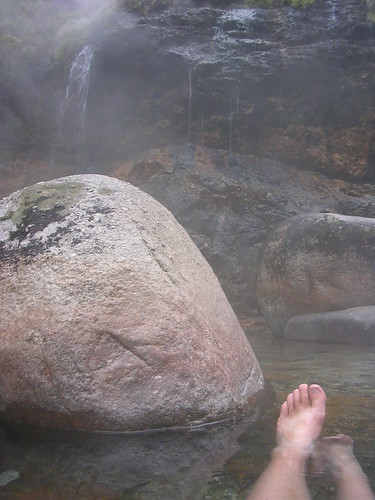 It was chilly and low clouds hung in the valley, but it made for a scenic gray day's ride and the relatively low temperature made it all the better when I stopped for a short hike into the woods to a hot spring someone told me about in Missoula. There was a bridge over the river (I had to wait for a man on horseback leading a string of pack mules to cross before I did) and then about a mile's walk through the woods to get to Jerry Johnson Hot Springs, where hot water poured down a short cliff and into Warm Springs Creek below. The hot water pooled in some rocks before running into the stream and I sat in it for a while enjoying the water and the view of the foggy, drizzly woods.
It was chilly and low clouds hung in the valley, but it made for a scenic gray day's ride and the relatively low temperature made it all the better when I stopped for a short hike into the woods to a hot spring someone told me about in Missoula. There was a bridge over the river (I had to wait for a man on horseback leading a string of pack mules to cross before I did) and then about a mile's walk through the woods to get to Jerry Johnson Hot Springs, where hot water poured down a short cliff and into Warm Springs Creek below. The hot water pooled in some rocks before running into the stream and I sat in it for a while enjoying the water and the view of the foggy, drizzly woods.
I rode on after that to the town of Lowell, through the gorgeous, undeveloped Lochsa River Valley. The road ran through the Clearwater National Forest, which was separated by the river from the Bitteroot National Wilderness Area. I had been planning to camp at a Forest Service campground, but the shopkeeper in Lowell told me that for a dollar more, I could camp at the motel/resort in town, and use their showers, pool, and hot tubs. That's a lot of hot water for one day. Jerry Johnson was better than the chlorinated warm pool I read my book in under the stars, but I didn't complain to the management.
I met a man at a roadside historical marker and he said he was envious. I didn't say it then because it didn't seem right, but I would be, too.
Posted by
Maggie
at
3:33 PM
1 comments
![]()
Tuesday, September 12, 2006
Wildfires
Missoula, MT -- Since South Dakota, things have been catching on fire. A cigarette butt will do it, or if it's dry enough, a combine hitting a rock can spark one, but usually lightening starts the land burning.
I drove around with two ranchers during a storm and every time a bolt of lightening hit the horizon they grimaced. The next day was going to be a long one, they told me, of putting out prairie fires. Nothing would burn much that night -- it was raining, after all -- but the few embers that the lightening sparked could keep themselves going over night, and when the wind picked them up in the morning and blew them to some fresh, flammable dry grass, the fires would start.
In Hobson, MT, I woke up in the middle of the night to a blaring siren coming from downtown. Alarmed and bleary-eyed, I walked a few blocks wondering if it was a tornado warning or an air raid siren. It was a fire. Fifteen miles out of town, a haystack had been lit up by a lightening bolt and the siren was to bring everyone who could to come and try to contain the burning. Even the quickest response couldn't salvage the hay -- this rancher will have to buy winter feed for his cattle this year, or if he can't afford that he'll have to sell them.
Over the next week or so in the plains I rode through quite a few blackened, barren patches of land that smelled strongly of charcoal. Range fires move fast because dry grass burns fast. Fires can race across grassland and leave almost nothing behind them. Because of this, though, a contained fire will run out of fuel relatively quickly and burn itself out. Those same embers that may have started the fire, though, need to be watched so that they don't start things up all over again.
A pair of Wyoming brothers told me about one of the first fires they fought, back in their teens when they were barely old enough to be helping out and excited to be there at all. Their detail, though, wasn't exactly thrilling work. They were left in charge of the site after the flames had been extinguished and it was their job to watch and wait and spray any embers that flared up. The two of them had to sit there for hours, they said, before anyone showed up to relieve them.
Forest fires move more slowly than range fires, but that can actually make them harder to contain. A camp fire can burn for several hours, after all. Imagine a campfire made of trees instead of logs. Forest fires are also usually harder to get to than range fires. When a lightening strike starts the mountains burning, the fire can be miles away from the most primitive road, and no one might even notice the fire until it grows.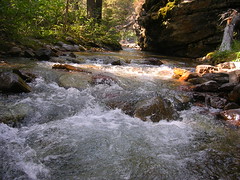 I rode through Glacier National Park last week, and it was scenic in the way it's supposed to be. Snowcapped peaks, blue alpine lakes, bubbling brooks and sweeping, panoramic views. But rather than the clear mountain air I was expecting, I looked at the more distant peaks through a light haze. There had been a big fire a few weeks before I got there and parts of it were still smoldering on the ridge above St. Mary's lake.
I rode through Glacier National Park last week, and it was scenic in the way it's supposed to be. Snowcapped peaks, blue alpine lakes, bubbling brooks and sweeping, panoramic views. But rather than the clear mountain air I was expecting, I looked at the more distant peaks through a light haze. There had been a big fire a few weeks before I got there and parts of it were still smoldering on the ridge above St. Mary's lake.
On my last day in Glacier, I picked out an 8 mile hike on the outskirts of the park, which I was hoping would be a little less crowded than the more central trails. The Northwest part of the McDonald Valley, where my hike to Apgar lookout was, had burned from mid-July of 2003 until the snow started falling that year. Fire crews had it more or less controlled by late August, and they kept it from harming much property or infrastructure, but thousands of acres of forest burned.
It was less crowded, and it was also completely different from the walks through greenery that I had done in the two days before. If the trees had branches, they were curled and blackened. At the base of the trees, though, on the forest floor, ferns and shrubs were green and growing. Some of them, actually, were starting to change color for the fall, and the yellows, oranges and reds doubled as a sign of regrowth and a reminder of the flames that had produced the landscape in the first place.
More than anything, those growing shrubs and bushes were a reminder that forests are supposed to burn. So is rangeland. It's part of a cycle of fire and regrowth that's essential to a healthy landscape. I went to a panel on management of forests before and after fires at the University of Montana here in Missoula and learned plenty about the ways that preventing forests from burning, or even logging a burned area, can alter the ecology of the woods. In New England, nutrients return to the soil when things rot, but out here it takes a fire.
I've talked to several firefighters here in Missoula, earlier on the road, and in a fire camp in Condon, MT, where over a hundred people were involved in fighting a fire in the Swan Mountains, on the Western side of the Rockies. Most of them volunteered to me that by putting them out, every year they were making the fires worse. When the fires aren't allowed to burn, more and more fuel just builds up, and that means that the next fire is that much hotter and that much bigger because it has that much more to burn. "By doing our job, we're creating our job," one of them said.
They were being a bit hard on themselves, though. Speakers presented other factors in why fires have been getting bigger and more frequent. Rising temperatures, for one thing, make snow melt earlier and water evaporate faster, so forests are more susceptible to fire by late in the summer. There's also a developing theory (more data is needed) that forests that have been logged tend to regenerate more densely and with a higher proportion of more flammable species of trees.
Whatever the cause of the increase in fire size and frequency, it's there. This summer, actually, is turning into one of the biggest fire seasons on record. The Great Falls Tribune in Central Montana published a story about it today. And letting the fires burn is becoming less and less of an option as more and more land is developed. Fires that threaten buildings, roads, and other infrastructure (the "urban interface," as it's referred to in wildfire fighting) get priority over ones that don't.
Getting priority, for a fire, is not just an honorary rank. There are very finite resources available for fighting fires and they go where they are thought to be needed most. A limited number of trained firefighters, limited money, limited aircraft, limited heavy equipment. The size of the fire, the level at which it is already contained, and it's threat to property and infrastructure determine what can be put into fighting it. The Tribune article details the stress that US firefighting personnel and resources are under right now. As one would expect, though, where resources are stretched, politics have a lot to do with what gets sent where. One firefighter told me over a beer about how he was shipped away from the Southwest, where a fire was threatening a fairly large number of small towns and mobile homes to Jackson Hole, where a fire was threatening a smaller number of millionaires' mansions. (Including Dick Cheney's, according to him.)
Containing a forest fire so that it doesn't burn down any houses is, like with a range fire, about all that can be hoped for. And to contain a fire, you remove its fuel. A guy who had fought fires in Yellowstone last summer told me about the process of building fire lines. When they approached a fire, they cut the branches off of trees in front of it so that the flames got smaller and smaller as they had less to burn. To finally halt the fire's progress they dug a ditch, only a couple feet wide, down to the mineral soil. By the time it got to the ditch the fire was only a couple feet high because there was so much less for it to burn, and it couldn't get over the ditch to the wood waiting on the other side.
The crew on the Swan Valley fire were excited about a low pressure system coming into the area in the next few days. The fire meteorologists at the National Weather service think it will bring snow, and that's good news for them. Not such good news for me, though. I'm leaving town tomorrow morning and heading into Idaho, out of the mountains, and hopefully away from the snow.
Posted by
Maggie
at
9:54 PM
1 comments
![]()
Friday, September 01, 2006
Backwards to Minnesota
Minneapolis, MN -- I've been taking a break. I took the train from
Shelby, MT to Minneapolis to see some friends and go on a canoe trip in the Boundary Waters -- a series of lakes in northern Minnesota along the Canadian border. I can't post pictures at this time, but trust me, it was gorgeous, and all the more so because the lakes and trees were a welcome contrast to so many miles of rolling, dry Montana plains.
This side trip has been full of welcome contrasts, actually. I've liked being in a city and having a variety of people all around me all the time. I've liked being able to hang out with people who share my background and situation to some degree -- recent college grads. It's been nice to stay in one place, and to go on a trip that someone else planned, and to have more than two radio stations available. It's been a very comfortable trip.
It's also been interesting to watch myself interact with strangers, here, though. On a somewhat stressful trip into strip-mall-land to replace my broken cell phone I found myself fairly annoyed at the leisurely cashier who tried to tell me jokes while checking me out. I would have listened to him gladly and probably even tried to further the conversation if I had been in small town Montana. Maybe that's just a habit that resurfaced with being in a city, but it's one I need to break. One of my favorite parts of my trip has been just listening to the things people tell me, and it'd be a pity to stop listening in major urban areas.
My train back to Montana leaves tonight so I'll be back on my bike and spending some time in Glacier National Park within a few days. Keep your fingers crossed against high altitude snow.
Posted by
Maggie
at
2:40 PM
0
comments
![]()
Tuesday, August 15, 2006
FAQ
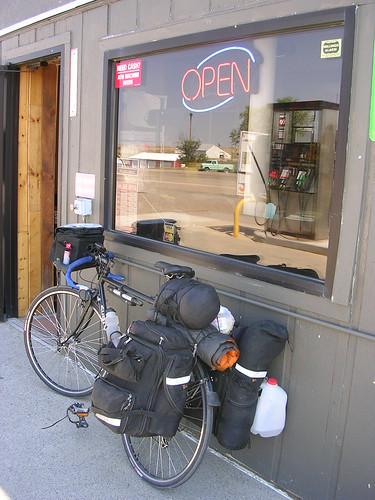
Harlowton, MT -- There's no better conversation starter than showing up somewhere on a loaded bicycle, but it almost always starts the same conversation.
Q: Where are you coming from? Where are you going?
A: Coming from Massachusetts, going to Oregon.
Q: All by yourself?
A: Yes, all by myself. And I like it this way. I can do whatever I want.
Q: Why? Are you raising money for charity or something?
A: Wanted to see the country and I don't have a car.
Q: Aren't you scared? There are a lot of bad people out there.
A: Sometimes I get nervous, but everyone's really nice. I keep hearing about these bad people, but I haven't met them yet.
Q: How many miles do you go in a day?
A: It depends on weather, hills, and distances between towns, but I average around 60 miles a day.
Q: I couldn't ride a bike to the other side of town. Isn't it hard?
A: Never so hard that it isn't worth it.
Posted by
Maggie
at
8:26 PM
2
comments
![]()
